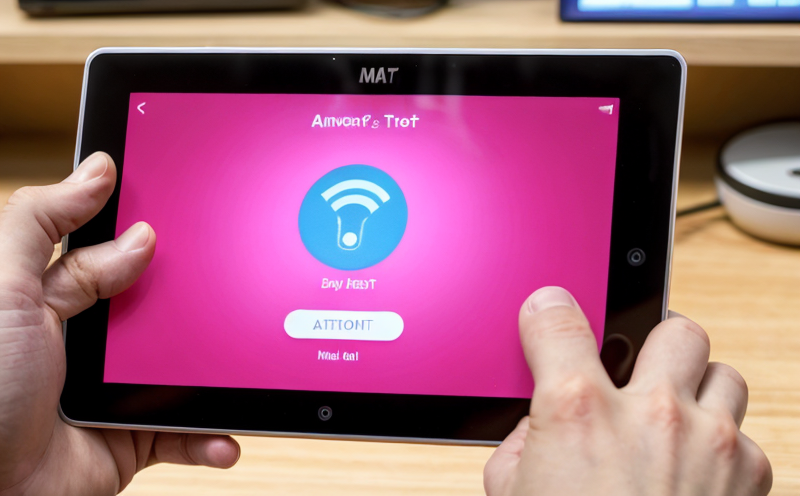Zigbee Connectivity Testing in IoT Consumer Products
As the Internet of Things (IoT) expands into consumer products, ensuring seamless connectivity between devices has become critical. Zigbee is a popular low-power, lossy network protocol designed for low data-rate applications in wireless personal area networks (PANs). In this context, Zigbee connectivity testing plays an essential role in verifying that IoT devices function correctly within the Zigbee network and meet the required standards.
The primary goal of Zigbee connectivity testing is to ensure that devices can communicate efficiently with each other, exchanging data securely and reliably. This service encompasses a range of tests including interoperability checks, security assessments, performance evaluations, and compliance verifications. By providing these services, we help manufacturers adhere to international standards such as IEEE 802.15.4 and Zigbee Alliance specifications.
During the testing process, our experts perform various tasks like setting up test environments that mimic real-world conditions, configuring devices with appropriate parameters, and monitoring their interactions. We use state-of-the-art equipment to capture detailed metrics about each transaction, ensuring nothing is overlooked during analysis. Our reports are comprehensive, providing insights into not only what went right but also areas where improvements could be made.
One key aspect of Zigbee connectivity testing involves interoperability checks between different brands and models of devices. This ensures that all connected products work together harmoniously without conflicts or dropped connections. Another critical component is security assessments, which focus on protecting user data from unauthorized access while maintaining robust encryption methods. Performance evaluations measure factors like latency, throughput, and reliability under varying loads to ensure smooth operation.
Compliance verifications guarantee that the tested devices meet relevant industry standards such as IEEE 802.15.4 for physical layer specifications and Zigbee Alliance specifications for higher layers of protocol stack. These include requirements regarding channel access, network formation, addressing schemes, security mechanisms, etc.
| Application | Description |
|---|---|
| Smart Home Devices | Incorporating Zigbee into smart homes allows for centralized control over various appliances ranging from lighting systems to security cameras. Testing ensures all components integrate seamlessly and operate securely. |
| Healthcare Monitoring | Zigbee enables continuous health monitoring by connecting wearable devices like heart rate monitors or glucose meters directly with central hubs for real-time data transmission. |
| Industrial Automation | For industrial settings, Zigbee can facilitate efficient communication among robotic arms, conveyor belts, and other machinery leading to optimized production processes. |
Our testing methodology ensures that every device meets stringent quality control measures before being released into the market. By partnering with us, businesses can rest assured knowing their products are thoroughly tested ensuring they not only perform well but also comply fully with applicable regulations.
Industry Applications
- Smarthome Devices: Ensuring seamless communication between various smart home devices such as thermostats, lights, and security systems.
- Healthcare Monitoring: Testing wearable health monitors that connect to central hubs for real-time data transmission.
- Industrial Automation: Facilitating efficient communication among robotic arms, conveyor belts, and other machinery in industrial settings.
| Application | Description |
|---|---|
| Smarthome Devices | Incorporating Zigbee into smart homes allows for centralized control over various appliances ranging from lighting systems to security cameras. Testing ensures all components integrate seamlessly and operate securely. |
| Healthcare Monitoring | Zigbee enables continuous health monitoring by connecting wearable devices like heart rate monitors or glucose meters directly with central hubs for real-time data transmission. |
| Industrial Automation | For industrial settings, Zigbee can facilitate efficient communication among robotic arms, conveyor belts, and other machinery leading to optimized production processes. |
Quality and Reliability Assurance
- Interoperability: Ensuring different brands and models of devices can communicate effectively within the Zigbee network.
- Security: Evaluating security measures to protect user data from unauthorized access while maintaining strong encryption methods.
- Performance Evaluation: Measuring factors like latency, throughput, and reliability under varying loads to ensure smooth operation.
- Compliance Verification: Guaranteeing that the tested devices meet relevant industry standards such as IEEE 802.15.4 for physical layer specifications and Zigbee Alliance specifications for higher layers of protocol stack.
We employ rigorous testing protocols to identify any potential issues early in the development cycle, allowing manufacturers ample time to address them before product release. This approach enhances both the quality and reliability of products going into the market, thereby improving customer satisfaction and trust.
Customer Impact and Satisfaction
By investing in Zigbee connectivity testing early on, businesses can significantly reduce costs associated with post-launch recalls or repairs due to faulty connections between devices. Moreover, satisfied customers are more likely to recommend your products positively, fostering brand loyalty which is crucial for long-term success.
Our services play a vital role in enhancing the overall user experience by ensuring that all connected devices work harmoniously without interruptions. This results not only in happier users but also increased sales and revenue growth for companies offering Zigbee-enabled products.





